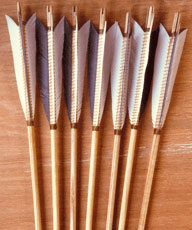Hi All
As promised.
Most of the literature suggests that you cut self nocks by hand. Essentially you place the shaft in a vice and then cut down the shaft using a number of hacksaw blades taped together.
Machine methods usually suggest hand feeding the shaft into some sort of cutting arrangement.
This is my method of doing it.
I already had the Triton fitted with a old, circa 1983, Skil saw. (The Skil was bottom of its range in its day but it has survived being abused for 20+ years by me. The saw blade is a Triton fine cut blade.
The block of timber has a number of holes to suit various sized shafts. You need to drill the holes vertically and I did it in a drill press. You also need to get the size right so that the shaft fits snugly - not tight nor loose. I drilled the holes to the nominal size and then used a number/letter drill set to enlarge them slowly till I got the correct fit. You could alternatively sand them.

As can be seen the block is just clamped to the Triton slide. Setup is relatively easy. Centre the slot over the saw blade and use it to set the depth of cut of the saw blade. Then clamp the timber to the slide, take a test cut and adjust laterally so that the nock is cut central in the shaft.
The black tape is to cover up the wide slot that is present in the Triton as it is wider than 5/16". Under the tape where you can see the cross taping is a thin piece of card which reinforces that area - stops it sagging from continually loading shafts.

This is the view down the bench and you can see the shaft in the slot ready to be fed through the saw.

The end result. Neatly cut self nock.
From this point I cross drill at the base of the slot to give a clip on effect and then sand and slighty round the end. The the area below the nock is bound and eventually the bidnding and end either varnished or if the arrow is to be wax finished coated with PVA before the wax finish is applied.
The saw blade does cut 'undersize' nocks and I suggest that people file them out to suit their bowstring/preference. In my own case I just leave - I am happy with the amount of grip they have.
Grahame.
Shoot a Selfbow, embrace Wood Arrows, discover Vintage, be a Trendsetter.
"Unfortunately, the equating of simplicity with truth doesn't often work in real life. It doesn't often work in science, either." Dr Len Fisher.








